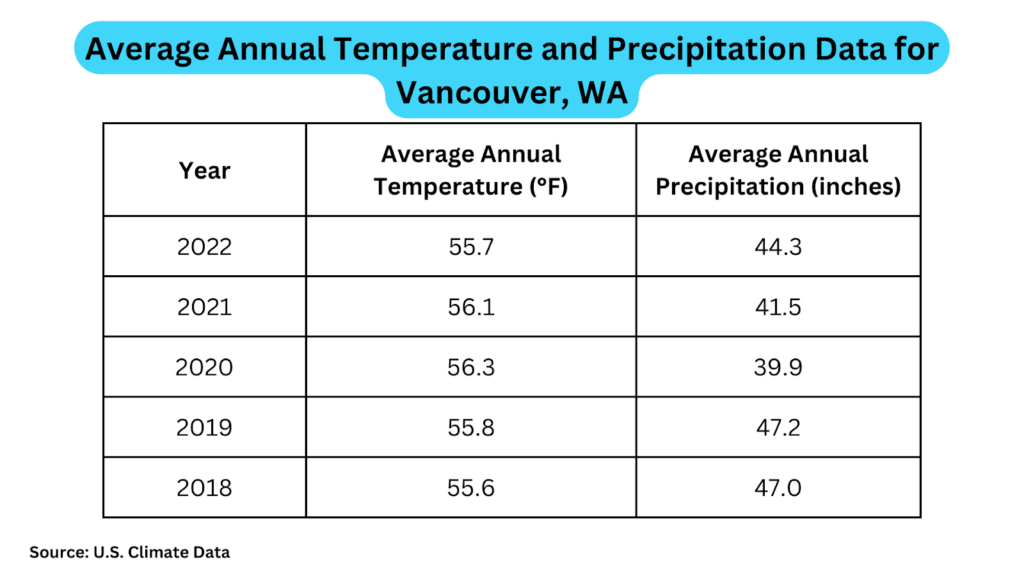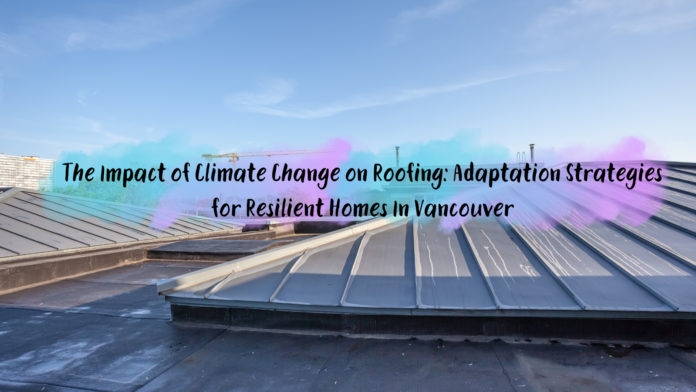Last Updated on April 28, 2024 by Umer Malik
Have you ever worried about your home’s roof withstanding extreme weather events like intense storms, heavy rainfall, and strong winds that are becoming more frequent due to climate change in the Vancouver area? Traditional roofing materials were not designed to endure the harsh effects of our rapidly changing climate, leaving many homes vulnerable to potential damage. As a homeowner in Vancouver, WA, have you considered how climate change impacts your roof and the necessary adaptation strategies to protect your valuable investment?
The Pacific Northwest region, known for its picturesque landscapes and temperate climate, is currently undergoing significant shifts in weather patterns due to climate change. Winters are becoming more intense with heavier rainfall and colder temperatures, while summers are drier and more sweltering. These changes have far-reaching implications for the roofing industry and homeowners. Roofs, as guardians of our homes, bear the brunt of nature’s fury. However, the escalating intensity of extreme weather events poses a challenge to traditional roofing materials not engineered for such relentless assaults. Consequently, Vancouver homeowners must reassess their roofing systems’ resilience to safeguard their cherished investments.
Table of Contents
Roofing Challenges in the Face of Climate Change
The once-predictable weather patterns in Vancouver, WA, have become increasingly erratic, subjecting roofing systems to unprecedented strains. Traditional roofing materials, ill-equipped to withstand the onslaught of heavy rainfall, hailstorms, and high winds, are now vulnerable points of entry for environmental havoc. Asphalt shingles, a staple in many homes, are particularly susceptible to damage from extreme heat and moisture, leading to premature deterioration and leaks.
Similarly, wooden shake roofs, though aesthetically pleasing, face increasing risk from wildfires, which have intensified due to climate change. Engaging the services of experienced roofing contractors Vancouver WA who possess expertise in navigating these climate-related challenges is crucial for homeowners seeking to protect their investments.
Furthermore, the ramifications of climate change extend beyond the physical integrity of roofing materials. Homeowners in Vancouver, WA, must also grapple with the financial implications of these challenges. Frequent roof repairs or replacements can strain budgets, while the potential for property damage due to failed roofing systems looms large. It is a sobering reality that underscores the urgency of adopting climate-resilient roofing strategies to protect not only our homes but also our financial well-being.

Adaptation Strategies for Resilient Homes
Choosing Climate-Resilient Roofing Materials
In response to the escalating threats posed by climate change, homeowners in Vancouver, WA, are turning to a new generation of roofing materials engineered for resilience. Metals, such as steel or aluminum, emerge as stalwart guardians against the elements, offering enhanced durability and longevity. Their superior resistance to wind, hail, and fire, coupled with their ability to shed precipitation efficiently, make them an attractive choice for homeowners seeking long-term protection.
Concrete tiles, too, have gained popularity as a climate-resilient roofing option. Their inherent resistance to extreme temperatures, moisture, and impact makes them well-suited for the volatile weather patterns of the region. Additionally, composite shingles, crafted from a blend of various materials, including fiberglass, asphalt, and recycled materials, offer a compelling combination of durability and sustainability.
However, the efficacy of these materials hinges significantly on the precision of installation techniques. Proper ventilation, underlayment, and flashing are crucial to ensuring the longevity and performance of climate-resilient roofing systems. It is advisable to enlist the services of experienced who possess the expertise to navigate the intricacies of these cutting-edge materials.
Enhancing Roofing Design for Climate Resilience
Beyond material selection, the architectural blueprint of a roof plays a pivotal role in fortifying homes against climatic upheavals. Factors such as roof slope, orientation, and drainage systems wield considerable influence in mitigating weather-related risks. Steep-sloped roofs, for instance, are better equipped to shed precipitation and resist wind uplift, reducing the likelihood of water damage and structural compromise.
Embracing innovative design paradigms, such as green roofs and cool roofs, further amplifies a structure’s resilience quotient. Green roofs, which incorporate living vegetation atop a building, offer insulation and stormwater management benefits, mitigating the impact of extreme heat and heavy rainfall. Cool roofs, on the other hand, employ reflective materials or coatings to reflect sunlight, reducing the burden on air conditioning systems and minimizing the urban heat island effect.
For homeowners in Vancouver, WA, seeking to enhance the climate resilience of their existing roofs, retrofit solutions may be a viable option. These can include installing additional insulation, improving ventilation systems, or incorporating drainage features to better manage water runoff. However, it is crucial to consult with professional roofing experts in Vancouver, WA, to determine the most effective and cost-efficient approach for each individual home.
Maintenance and Regular Inspections
The adage “prevention is better than cure” rings especially true in the realm of roofing maintenance. Regular inspections serve as a frontline defense against potential vulnerabilities, allowing homeowners to preemptively address issues before they escalate. In the face of climate change, this proactive approach becomes even more imperative, as extreme weather events can exacerbate existing weaknesses in roofing systems.
Equipping oneself with the knowledge of proper maintenance routines is paramount in safeguarding the structural integrity of roofing systems. This includes tasks such as clearing debris from gutters and downspouts, trimming overhanging branches that could potentially damage the roof during storms, and promptly addressing any signs of wear or damage.
For homeowners in Vancouver, WA, it is advisable to schedule professional roof inspections at least once a year, or more frequently if the region experiences particularly severe weather events. These inspections can be conducted by reputable companies, who possess the expertise to identify potential issues and recommend appropriate solutions.
| Adaptation Strategy | Key Factors | Considerations |
| Choosing Climate-Resilient Roofing Materials | – Metal (steel, aluminum) – Concrete tiles – Composite shingles | – Durability and longevity – Resistance to wind, hail, fire, and precipitation – Proper installation techniques (ventilation, underlayment, flashing) – Experienced roofing contractors |
| Enhancing Roofing Design for Climate Resilience | – Roof slope – Orientation – Drainage systems – Green roofs – Cool roofs | – Steep slopes for shedding precipitation and wind resistance – Effective water management – Insulation and stormwater management benefits (green roofs) – Reflective materials to reduce heat absorption (cool roofs) – Retrofit solutions (insulation, ventilation, drainage) |
| Maintenance and Regular Inspections | – Debris removal – Branch trimming – Addressing wear and damage – Professional inspections | – Proactive approach to identify vulnerabilities – Proper maintenance routines – Annual inspections (or more frequent after severe weather) – Reputable roofing companies for inspections and solutions |
Government Initiatives and Regulations
In recognition of the urgent need to bolster the resilience of residential infrastructure, local authorities in Vancouver, WA, have instituted a suite of regulations and building codes. These mandates aim to galvanize homeowners into action, fostering a culture of proactive adaptation in the face of climate uncertainty.
One such initiative is the incorporation of climate-resilient roofing requirements into the local building code. This ensures that new construction projects adhere to stringent standards, incorporating materials and design elements that can withstand the anticipated impacts of climate change. Additionally, the city may offer incentives or subsidies to encourage homeowners to retrofit existing homes with climate-resilient roofing solutions.
Furthermore, Vancouver, WA, has implemented measures to promote sustainable urban development, including the adoption of green building practices and the integration of green infrastructure. These efforts not only contribute to climate mitigation efforts but also enhance the overall resilience of the community, including its roofing infrastructure.
Final Thoughts
In the crucible of climate change, the roof emerges as a symbolic bulwark against the capricious forces of nature. For homeowners in Vancouver, WA, the imperative of proactive adaptation looms large on the horizon. By embracing innovative solutions, fostering collaboration, and heeding the lessons of the past, we pave the way for a future where resilience reigns supreme.
The path forward is clear: invest in climate-resilient roofing materials, prioritize sustainable design principles, and maintain a steadfast commitment to regular maintenance and inspections. By doing so, we not only fortify our homes against the challenges of a changing climate but also contribute to the collective effort to mitigate the impacts of climate change on our communities.
As the tides of change continue to swell, it is imperative that we remain vigilant and proactive, adapting our approach to roofing with the same agility as the evolving climate itself. For in the face of adversity, resilience becomes our greatest ally, ensuring that the roofs over our heads remain steadfast guardians of our homes and our way of life.
Frequently Asked Questions
Climate-resilient materials like metal, concrete tiles, and composite shingles have a higher upfront cost but offer long-term savings through their durability, weather resistance, and potential insurance discounts. The initial investment can pay off with fewer repairs and replacements needed over time.
Retrofitting with added insulation, ventilation improvements, or drainage features may enhance resilience for some roofs. However, if your roof is nearing its lifespan or heavily damaged, a complete replacement with climate-resilient materials is likely the better long-term solution.
Regular inspections, at least annually or after severe weather events, are crucial for identifying and addressing potential issues early. Proper maintenance, like clearing debris and trimming overhanging branches, also helps extend your climate-resilient roof’s lifespan.























